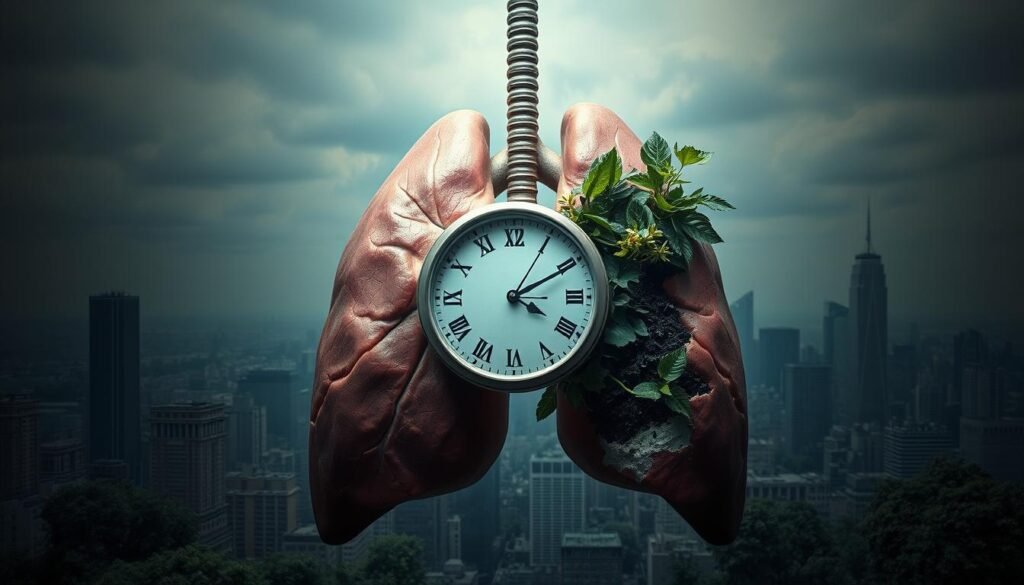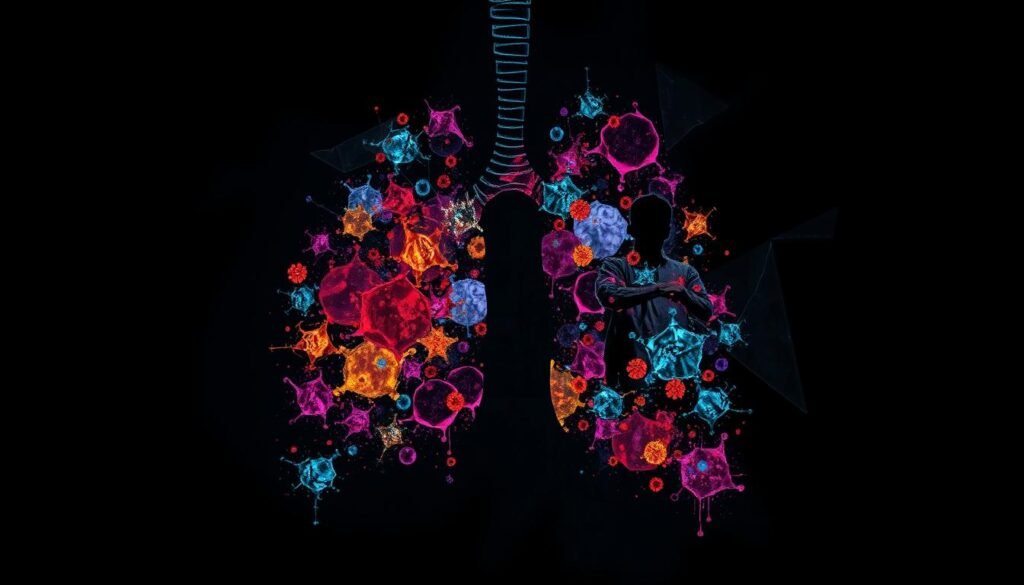Lung cancer is the most deadly form of cancer. About 65% of people found with stage 1 cancer live for five years or more. But at stage 4, 95% do not make it to that point. This difference highlights how lung cancer’s spread affects how long people live. Patients and families dealing with this diagnosis need to understand the timeline. They also need to know about the key factors that influence how long someone can survive. This knowledge helps them make informed choices.
When we talk about how long lung cancer takes to be fatal, it’s crucial to consider many things. These include the disease’s stages, the outlook for lung cancer patients, and new treatments that could help. Knowledge is key. Being well-informed can help patients and their families handle the difficulties lung cancer brings.
Key Takeaways
- The five-year survival rate for lung cancer is about 19% overall.
- 65% of people diagnosed at stage 1 live five years or more, but only 5% at stage 4 do.
- Young people often have a better chance of living longer after being diagnosed.
- Finding the cancer early greatly increases the chances of survival.
- There are currently over 1,500 clinical trials in the U.S. looking to improve lung cancer treatments.
- Knowing the symptoms and catching the disease early are key to a better outcome.
Understanding Lung Cancer
Lung cancer starts in the lungs. It is split into two main types: non-small cell lung cancer (NSCLC) and small cell lung cancer (SCLC). NSCLC is more common and grows slowly. SCLC spreads quickly.
Common symptoms include a lasting cough, shortness of breath, and chest pain. These signs often don’t show up until the cancer is advanced. Knowing these symptoms is important for early checks.
Many things affect lung cancer’s growth. Smoking and secondhand smoke raise the risk a lot. Environment and genes also matter. Knowing this helps with prevention and screening talks, especially for those at higher risk.
How Long Does It Take for Lung Cancer to Kill You
Lung cancer is aggressive and survival outcomes vary widely. Several factors play a role, making it essential for patients and their families to understand them. The lung cancer survival rate changes from person to person, impacting how long someone lives with the disease.
Factors Influencing Survival Rate
Many things can change the lung cancer survival rate. These include:
- Stage of lung cancer at diagnosis
- Type of lung cancer (e.g., small-cell lung cancer vs. non-small cell lung cancer)
- Patient’s overall health and age
- Response to treatment options such as chemotherapy and radiation
Statistics show that over half of those with lung cancer die within a year of finding out they have it. The actual time lung cancer takes to be fatal varies a lot. Without treatment, patients with advanced small-cell lung cancer may live only 6-12 weeks. However, with the right treatment, some live several months longer.
Importance of Early Diagnosis
Early detection makes a big difference in survival rates. Screenings are crucial, especially for heavy smokers aged 50 to 80. Catching lung cancer early improves the effectiveness of treatments. This can lead to longer life and better quality of life. For insights into how lung cancer spreads, check out this article on how fast lung cancer spreads.
Stages of Lung Cancer
Knowing each stage of lung cancer is key in figuring out the outcome and treatment choices. This illness has various stages, from stage 1 where it’s only in the lungs, to stage 4 where it has spread far. Each stage brings its own set of challenges and treatment possibilities. Understanding these stages helps in knowing the survival rates of lung cancer.
Overview of Each Stage
The progress of lung cancer is shown through its stages:
- Stage 1: The cancer is small and only in the lungs, without spreading to lymph nodes.
- Stage 2: The cancer may grow larger and start to affect nearby lymph nodes.
- Stage 3: It may spread to the chest wall or nearby lymph nodes on the lung’s side.
- Stage 4: This is the most serious stage, where the cancer has spread to other organs, changing the approach to treatment.
Survival Rates by Stage
The stage of lung cancer at diagnosis greatly impacts survival rates. About 65% of people found at stage 1 might live for five more years. This chance lowers greatly, to about 5%, for those diagnosed at stage 4. Knowing these survival rates is crucial for patients and families making treatment choices. Early discovery, by being aware of risk factors, can better these odds. For tips on prevention and more on how lung cancer relates to environmental issues, click here.
Lung Cancer Life Expectancy
Lung cancer life expectancy differs a lot based on stage and the cancer type. Untreated non-small cell lung cancer has a survival from 5 to 12 months after being found. For small cell lung cancer, it’s even shorter, with three to 15 months without treatment.
Early detection can lead to better survival chances. The five-year survival for early-stage non-small cell lung cancer could be up to 56%. Yet, 80% of lung cancers are found late, making the outcome worse. For advanced lung cancer, the five-year survival drops to about 7%.
Here are the median survival rates without treatment for non-small cell lung cancer:
| Stage | Median Survival (Months) |
|---|---|
| Stage I | 13.7 |
| Stage II | 8.4 |
| Stage IIIA | 6.1 |
| Stage IV | 2.0 |

Age, health, and other conditions impact lung cancer life expectancy a lot. Some avoid treatment due to quality of life concerns, cost, or belief in treatment success. It’s key to get full care and support to make wise choices about managing lung cancer. For uninsured or underinsured people, Medicaid and the American Cancer Society offer essential help. For more on life expectancy and survival rates for metastatic lung cancer, look at this source.
Lung Cancer Survival Rate
Lung cancer survival rates are key to understanding a patient’s prognosis. They show the hurdles faced by those diagnosed. And they highlight how different types of lung cancer affect survival.
Knowing these rates helps patients and caregivers decide on treatment and care.
General Survival Statistics
About 25.4% of those with lung and bronchus cancer live at least five years. This fact underlines the disease’s deadliness. Survival rates vary a lot, depending on when the cancer is found:
| Stage of Cancer | Five-Year Survival Rate |
|---|---|
| Localized (cancer only in the original location) | 62.8% |
| Regional (cancer in nearby lymph nodes) | 34.8% |
| Metastatic (spread to other organs) | 8% |
These numbers show why catching cancer early is crucial. A person’s chance of surviving depends on the cancer type, stage, and treatment. For example, those with non-small cell lung cancer (NSCLC) usually do better than those with small cell lung cancer (SCLC).
Differences by Cancer Type
Survival rates differ significantly between lung cancer types. NSCLC patients often fare better, with survival depending on the subtype. On the other hand, SCLC patients usually face a harder fight with lower survival chances. Here are some life expectancies based on cancer type:
| Cancer Type | Average Life Expectancy |
|---|---|
| NSCLC (with treatment) | 76.7 months |
| SCLC (extensive stage) | 7-11 months |
| Lung carcinoid tumors | 5.6 years |
This shows the big differences in how lung cancers are treated and outcomes. It emphasizes the importance of quick action to improve survival rates. These stats give patients and families useful info for their treatment path.
Lung Cancer Prognosis
Lung cancer’s outlook can differ a lot between patients. Factors affecting prognosis are key in knowing what to expect for someone with lung cancer. Understanding these helps patients and families get ready, choose treatments, and take better care of their health.
Understanding Your Prognosis
The outlook for lung cancer depends on many things. These include whether it’s non-small cell or small cell lung cancer, how early it’s found, and the patient’s health. Sadly, more than 80% die within five years of finding out they have it. This is often due to how quickly it gets worse.
Doctors usually use statistics to talk about the prognosis. But remember, these numbers might not perfectly apply to everyone. When lung cancer reaches stage 4, it’s really serious. That’s because it spreads far, making things much harder. Catching it early and knowing the can help a lot with treatment and living better.

The size and spread of tumors, or tumor burden, matters too. A high tumor burden means a higher chance of dying because it’s harder on the body. Complications like infections or blood clots make treatment even more difficult. So, knowing all the factors affecting prognosis helps doctors make the best plan for care, aiming to improve life for people with lung cancer.
Terminal Lung Cancer
Terminal lung cancer is the last stage of the disease when treatments don’t work. At this point, life expectancy drops to months or even weeks. Understanding this phase is key for patients and families as it brings complex feelings and a need to rethink future plans.
Defining Terminal Lung Cancer
Terminal lung cancer usually means a stage IV diagnosis, with the cancer spreading far. Sadly, 25% to 30% of stage IV NSCLC patients die within three months of finding out.
However, about 10% to 15% live much longer, some even years. This shows how unpredictable this illness can be and highlights the importance of personalized care plans.
Emotional and Psychological Impact on Patients
Being told you have terminal lung cancer deeply affects you and your loved ones. Patients face anxiety, fear, and a sense of losing control. Families, too, deal with major emotional changes, bracing for loss.
Getting enough support, like counseling and joining support groups, is crucial. It helps deal with these tough emotions. Talking openly about feelings, fears, and end-of-life wishes makes coping a bit easier for everyone involved.
Metastatic Lung Cancer
Metastatic lung cancer happens when the cancer moves from the lungs to other body parts. This makes treatment harder and greatly affects how long patients might live. Only about seven percent of people with this cancer live for five years or more. For specific types like stage 4 small cell lung cancer, the number drops to three percent.
The cancer can spread to the brain, liver, and bones, causing different symptoms. For example, spreading to the brain might make someone feel sleepy or confused. If it goes to the liver, the right side of the belly might hurt.
Some symptoms of metastatic lung cancer are:
- Persistent cough
- Weight loss
- Chest infections
- Hoarseness
Doctors pick treatments for metastatic lung cancer based on the cancer type and the patient’s health. They often use chemotherapy, targeted therapy, and immunotherapy. These treatments help manage symptoms and slow the cancer down.

End-Stage Lung Cancer
End-stage lung cancer is the last stage of the disease. It comes with many physical and emotional challenges. Those facing it often deal with hard symptoms as their body can’t cope well. Understanding these symptoms and how they affect life is key for good care and support.
Symptoms of End-Stage Lung Cancer
This stage has very tough symptoms. The often seen lung cancer symptoms are:
- Severe breathlessness, often needing extra oxygen.
- Chronic cough that hardly brings up sputum.
- Great weakness, making moving and daily tasks hard.
- Losing appetite and trouble swallowing, leading to losing a lot of weight.
- Mind issues like confusion about where and when it is.
- Feeling very restless and more anxious.
Changes in Quality of Life
As end-stage lung cancer gets worse, quality of life clearly changes. Patients often need a lot of help, like with moving around and keeping clean. Typically, you’ll see:
- Changes in how the body works, especially eating much less.
- How one breathes changes, including stopping for short times.
- Being less social and feeling more alone.
- Physical changes like cold hands and feet and changing blood pressure.
Caregivers are very important for those with end-stage lung cancer. They closely watch for symptom changes, give medicines on time, and support emotionally. Recognizing and managing this disease’s aspects really helps patients and their families.
Lung Cancer Mortality Rates
Lung cancer is a major health issue. It leads to many deaths linked to cancer each year. Knowing the death rates from lung cancer helps us see how big the problem is. It also shows why it’s important to find and treat lung cancer early.
Statistics on Lung Cancer Deaths
In 2021, lung cancer killed 134,592 people. This number was 22% of all cancer deaths in the U.S. Out of these, 71,549 were men and 62,955 were women. The death rates showed big differences between men and women. They were 37% higher in men, at 37.4 per 100,000 people, than in women, at 27.3 per 100,000.
Looking back, we see changes in death rates from lung cancer. From 1930 to 1990, these rates went up. They reached their highest at 91.1 per 100,000 for men in 1990, and 41.6 per 100,000 for women in 2002. Then, the rates started to drop. Since then, death rates decreased by 59% for men and 34% for women. In just the last ten years, lung cancer death rates dropped 35% for men and 26% for women. Even with these improvements, some groups still have higher death rates. Black men had the highest rates, at 51.0 per 100,000 between 2016 and 2020.
Common Causes of Death in Lung Cancer Patients
Lung cancer deaths come from a few main causes. Organ failure, often due to the cancer, is a common cause. So are infections and complications from cancer spreading. These causes highlight how critical early diagnosis and right treatments are. The table below shows survival rates by cancer stage. It gives a clearer picture of what patients might expect.
| Stage | 5-Year Survival Rate (%) |
|---|---|
| Stage 1 | 65 |
| Stage 2 | 40 |
| Stage 3 | 15 |
| Stage 4 | 5 |
Living with Lung Cancer
Facing lung cancer is tough. But people can live better by handling symptoms and treatments well. This means taking the right meds, using therapies, and living healthier. Having support helps a lot. Friends and other helpers can give both emotional and practical support.
Managing Symptoms and Treatments
Knowing treatment options helps a lot when you have lung cancer. Surgery may be the first choice if the cancer is caught early. If surgery isn’t an option, treatments like radiation or chemotherapy might work. Here are some key methods:
- Stereotactic ablative body radiation therapy
- Continuous hyperfractionated accelerated radiotherapy
- Adjuvant chemotherapy
- Radiofrequency ablation
Dealing with symptoms like coughing, chest pain, and being tired is important. Taking care of these symptoms helps people feel better. And acting quickly can help people live longer and more comfortably.
Support Networks for Patients
Having a strong support network is key for lung cancer patients. Family, friends, and support groups provide help and emotional support. This support gives patients the strength to face treatment and recovery.
- Emotional reassurance and companionship
- Access to shared experiences and coping strategies
- Encouragement to stay engaged in treatment plans
- Information about resources and additional support options
Support makes dealing with lung cancer easier. Connecting with others in the same situation brings hope. And it helps people manage their cancer journey better.
Conclusion
Knowing about lung cancer is key for both patients and their loved ones. It greatly affects treatment choices and everyday life. As a top cancer in the U.S., it’s the main reason for cancer deaths. It’s vital to spread the word about lung cancer.
About 80% to 85% of lung cancers are non-small cell lung cancer (NSCLC). The survival rates vary by stage. This knowledge encourages people to get help early.
Getting diagnosed early is critical for survival. Localized NSCLC has a 5-year survival rate of 65%. But, if cancer spreads, survival rates drop a lot. This fact shows why lung cancer screenings are so important.
The American Lung Association stresses screening, especially for smokers or those who used to smoke. Early detection can mean better treatment options.
To sum up, spreading awareness about lung cancer can help society. It emphasizes early diagnosis, effective treatments, and support networks. This way, we can tackle lung cancer’s challenges better.